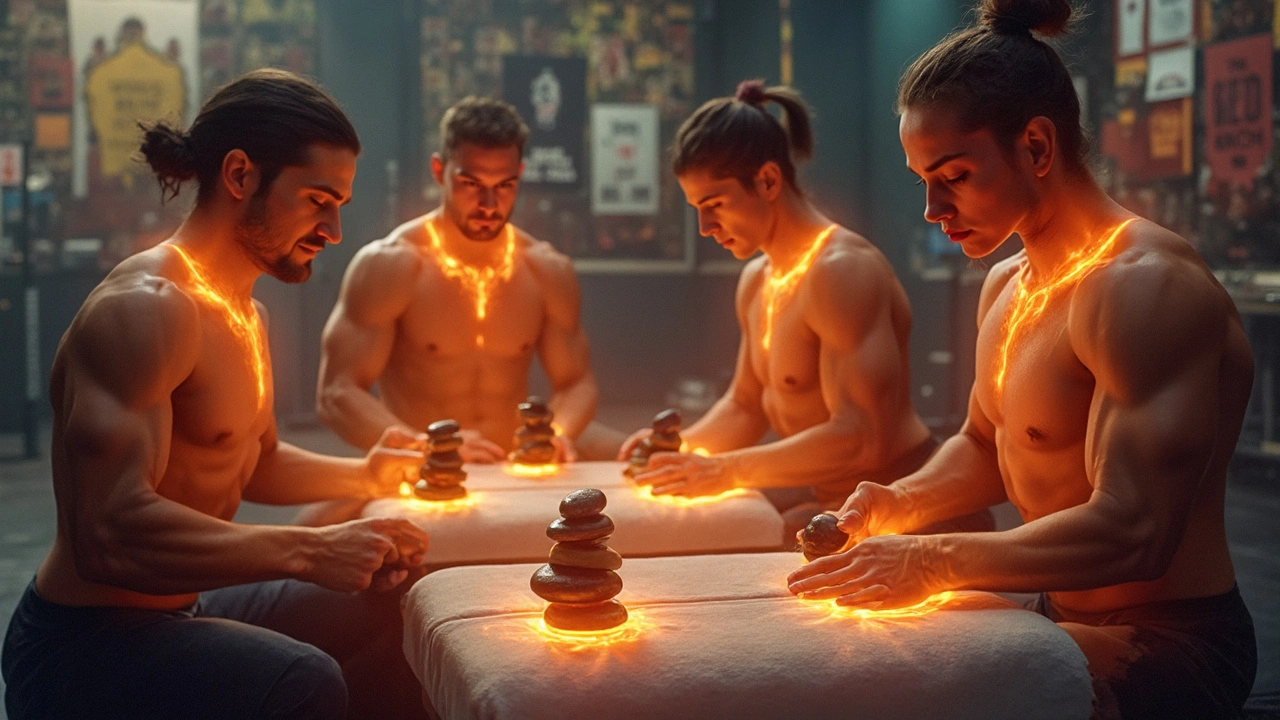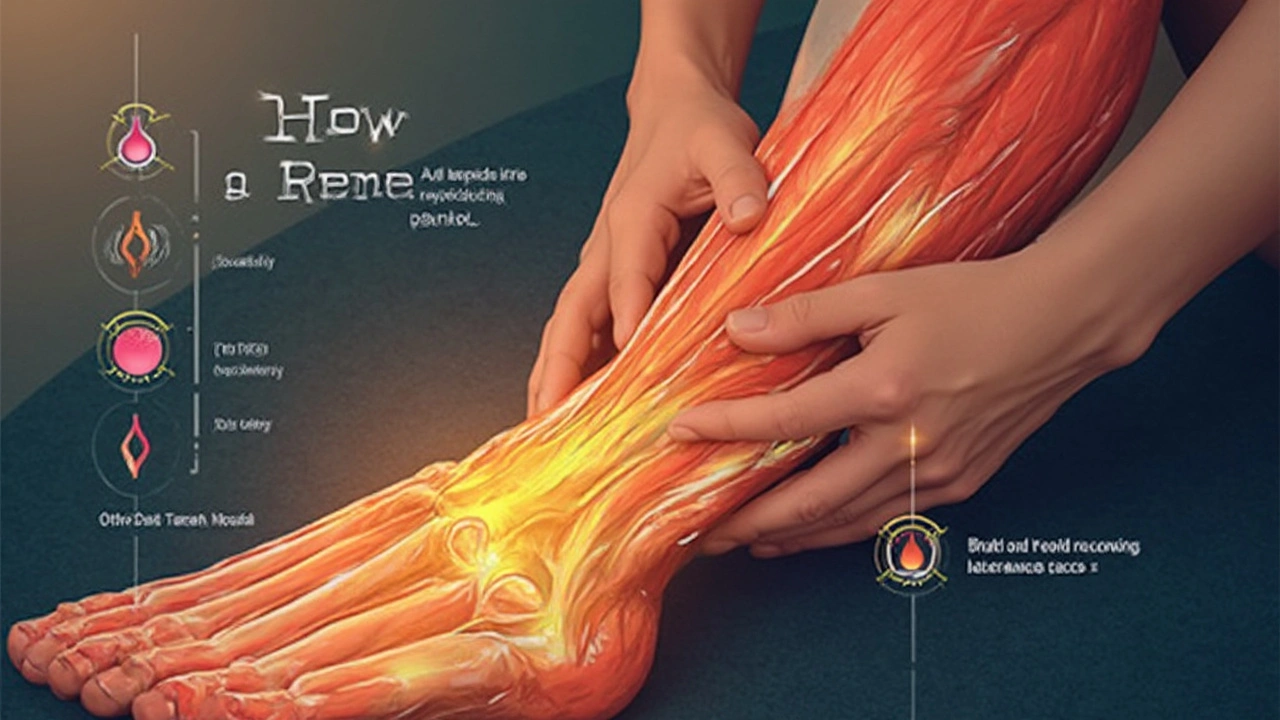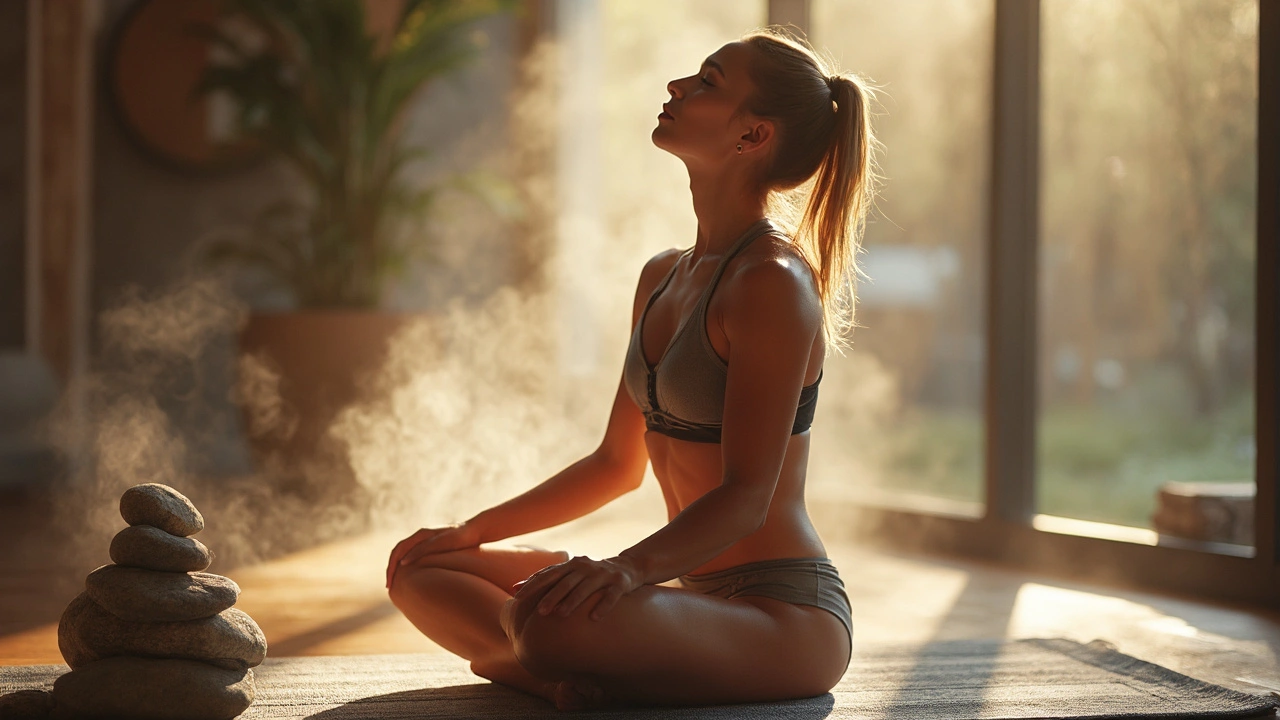Imagine stepping off a tough workout, muscles screaming, and finding a recovery method that feels amazing and actually works. That's the promise of hot stone massage—it's not just spa fluff; it's functional. Those smooth, heated stones aren't used for decoration. Placed on key spots, they get deep heat right where you ache, loosening muscles in ways regular rubdowns can't touch.
If you’re chasing real results from your workouts—more gains, less pain—recovery needs to be a top priority. Sore shoulders after upper body day? Stiff lower back from too many squats? Hot stone massage unlocks tight spots, helps blood flow faster, and may even boost flexibility. Plus, getting that real, heavy warmth melting into your muscles shuts down stress, making it easier to stay motivated and consistent with your fitness grind.
- What Actually Happens During Hot Stone Massage?
- Why Hot Stone Massage Works for Fitness Buffs
- When to Schedule a Session in Your Workout Week
- Tips to Maximize Your Massage Results
- Common Misconceptions (And What Really Matters)
What Actually Happens During Hot Stone Massage?
First, let’s clear up one thing: a hot stone massage isn’t just someone placing a few warm rocks on your back and calling it a day. There’s a method behind it, and it’s way more targeted than you might expect. Here’s how it usually goes down. You lie face-down on a comfy massage table, and the therapist heats up smooth, flat stones—usually basalt, because it holds heat really well—then places them on certain points along your body, like your spine, shoulders, or calves.
Believe it or not, these stones can get to about 120–130°F (49–54°C). It's not burning—you’re not a pizza—but you’ll feel warmth rush right through your tight spots. Sometimes, the therapist glides the hot stones over sore muscles with oil, combining heat and massage. That deep-in-the-muscle warmth helps muscles relax faster than with just hands.
What’s actually happening under the skin? The heat from the stones causes your blood vessels to expand—a process called vasodilation—which boosts blood flow. This helps your body clear out waste products that build up during tough workouts. It’s like sending a cleaning crew right to your tired muscles. Plus, research shows that hot stone massage can drop your stress hormone levels, leading to lower heart rate and better sleep.
Most sessions last about 60–90 minutes. If you’ve got specific trouble spots (hello, sore quads after leg day), talk to your therapist; they’ll focus the stones there. Expect a mix of stones resting and moving, sometimes alternating with quick cold stones to pump up circulation even more. Don’t be shy—if the stones feel too hot, say something. A good therapist checks in, but it’s your session.
- Preparation: Stones are sanitized and heated in a water bath, not microwaved (thank goodness).
- Placement: Stones go on key muscle points or get glided across your skin with massage oil.
- Duration: Stones are sometimes swapped out to stay warm throughout the session.
- Results: Expect muscles to relax, stress to melt down, and your body to feel limber and refreshed post-workout.
| Massage Length | Temperature Range | Main Stone Material |
|---|---|---|
| 60–90 min | 120–130°F (49–54°C) | Basalt |
The bottom line: hot stone massage gives your muscles a head start on recovery and helps you bounce back faster, ready to crush your next fitness goal.
Why Hot Stone Massage Works for Fitness Buffs
If you hit the gym hard—or run, cycle, or play sports—you know muscle pain isn’t just annoying, it can mess up your training schedule. The real trick? Boosting recovery without having to pop painkillers or spend days sidelined. Here’s where hot stone massage comes in clutch for the fitness crowd.
These sessions use smooth, heated basalt stones placed on specific muscle areas. Why does this work so well? Heat dilates blood vessels, ramping up circulation. That means more oxygen and nutrients hit your muscles, and waste products (like lactic acid that causes soreness) are flushed out faster. Science actually backs this up. One study in the Journal of Alternative and Complementary Medicine found that massage with heat increased local blood flow by up to 50% compared to traditional massage. That’s not a minor difference when you’re chasing quicker muscle repair after a brutal session.
But it’s not just about circulation. Hot stone massage also lets the therapist use less pressure to achieve deeper tension release. You know that feeling when a knot won’t quit, and digging in hurts like hell? The heat softens tissues, making muscles more pliable, and the stones do some of the heavy lifting—so your recovery is pain-free instead of pain-full.
Here’s what fitness buffs often notice after adding hot stone massage into their routine:
- Reduced muscle soreness the next day (so you can move without wincing)
- Improved flexibility and range of motion (perfect before a big deadlift or squat session)
- Better sleep, which is key for muscle growth and fat loss
- Lower stress hormones—cortisol drops, which amps up recovery
Check out how a hot stone session stacks up for key workout recovery needs:
| Recovery Need | Hot Stone Boost |
|---|---|
| Muscle Soreness | Less soreness in 24-48 hrs |
| Flexibility | Muscles feel looser, joints move easier |
| Chronic Knots | Deep heat relaxes stubborn spots |
| Motivation | Less pain and more relaxation = more gym consistency |
So, the next time you’re feeling wrecked after a tough training block, remember: hot stone massage isn’t some spa gimmick. It’s a tool to keep you going strong, long-term.

When to Schedule a Session in Your Workout Week
Timing matters with hot stone massage if you want real fitness results. Don’t just book it whenever—your muscles have different needs depending on your workout cycle. A lot of trainers suggest fitting a session either right after your toughest training day or on your rest day. Right after an intense workout, your body’s blood flow is already up; add heat and you help flush out all that soreness before it fully sets in. On rest days, massage becomes a full-blown recovery tool, speeding muscle repair and helping you come back stronger.
If you’re training hard or prepping for a big event, one hot stone treatment per week could be a game changer. For those pushing double sessions or lifting heavy five or six days a week, some coaches recommend every four or five days. But don’t overdo it—too many massages too close together, and you might end up with more fatigue (plus, it gets expensive).
Here’s a quick guide:
- After a major workout, like leg day, for deeper muscle relief
- On an active recovery or rest day to speed up repair
- Avoid scheduling it right before your workout—relaxed muscles might feel awesome, but they can make you a bit wobbly or slow for heavy lifts
- If you’re new to fitness recovery routines, try one session every two weeks and see how your body responds
One study in the Journal of Strength and Conditioning Research found that athletes getting deep tissue massage (including hot stone) right after training reported lower muscle soreness by nearly 30% the next day, compared to those who skipped it. That’s the difference between dragging yourself through the next session or actually crushing it.
Plan it smart, listen to your body, and let the stones do their thing at just the right time. Your muscles will thank you—and you might actually look forward to recovery days.
Tips to Maximize Your Massage Results
If you’re grabbing a hot stone massage to boost your fitness recovery, a few simple moves can make a huge difference in how much you get out of each session. Don’t just book it and show up—show up smart.
- Hydrate before you go. Your muscles loosen up more when you’re not dehydrated, and all that heat helps release toxins, so water helps flush them out. Drink at least a bottle of water before your appointment, and keep sipping after.
- Don’t train right before your session. Give your body a couple of hours between your workout and your hot stone massage. This lets your muscles cool down a bit and lowers the risk of muscle cramps or bruising.
- Shower before, not after. Take a warm shower before your session to get clean and let your muscles start relaxing. After the massage, your skin may be more sensitive or oily; wait a few hours before showering again.
- Communicate with your therapist. Tell them exactly where you’re sore or tense—they need to know if you’ve got tight calves from running, or a locked-up lower back from deadlifts. They’ll focus the heated stones where you actually need it most.
- Skip heavy food and caffeine beforehand. You’ll relax better and avoid feeling queasy if your last meal was at least an hour ago and light. Too much coffee amps you up, which works against the chill-out factor.
If you go regularly, try booking your hot stone massage the day after your most intense workout. Studies show that the effects of massage, including reduced muscle soreness and improved range of motion, are most noticeable when spaced 24 hours away from big training days.
| Frequency | Reported Muscle Soreness (1-10 scale) | Average Flexibility Gain (%) |
|---|---|---|
| Weekly | 3 | 12 |
| Biweekly | 5 | 7 |
| Rarely | 7 | 2 |
That’s a big drop in soreness and a real bump in flexibility just by getting on a regular schedule. So if you want every workout or run to count, treat your hot stone massage like part of your actual training, not just a treat.

Common Misconceptions (And What Really Matters)
There’s a lot of bad info floating around about hot stone massage. Let’s clear things up so you know what actually works—and what’s just gym myth.
First, people sometimes think it’s only for luxury or it’s not effective for real athletes. That’s flat-out wrong. Multiple sports recovery studies show that heat therapy, especially with stones, reduces muscle tension better than just resting. Real talk: Denver Broncos introduced this as part of their team recovery protocol in 2022. If it’s good enough for pros, it’s legit for anyone serious about fitness.
Another myth? Hot stone massages are just glorified relaxation methods. Yes, they feel good. But lazy? Not even close. The heat increases blood flow, which actually speeds up the body’s recovery process after heavy lifts or runs. If you’re after faster muscle repair, a hot stone massage helps your system do its work.
Some folks worry about the stones causing burns. In reality, certified therapists always check temperature and move stones to protect your skin. If you’re thinking of trying it at home, use common sense—never slap scalding rocks straight from a pot onto your back. Trust the pro’s setup for real results and safety.
People often assume hot stone massage works just like a classic massage with a side of heat, but there’s more science behind it. The stones allow therapists to work out deep knots without extra pressure, meaning less soreness afterwards.
| Misconception | Fact |
|---|---|
| Only for pampering | Used by top sports teams for actual recovery |
| Dangerous burns are common | Certified pros use safe temperatures |
| Heat is just for relaxation | Boosts circulation and reduces muscle pain |
| Doesn’t really help athletes | Science backs up faster recovery |
If you want to see if it’s for you, talk with your massage therapist about your workout routine. Ask them to target specific recovery zones after a tough session. The key thing? Don’t judge hot stone massage by what you’ve seen in movies or heard from skeptics. Ask the pros, and look at the real evidence—the difference can seriously surprise you.




